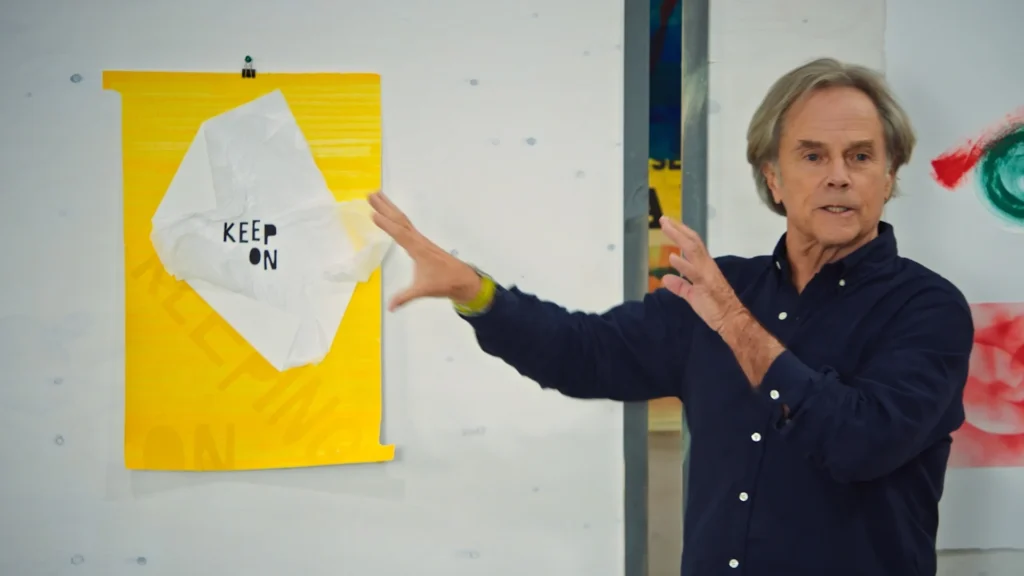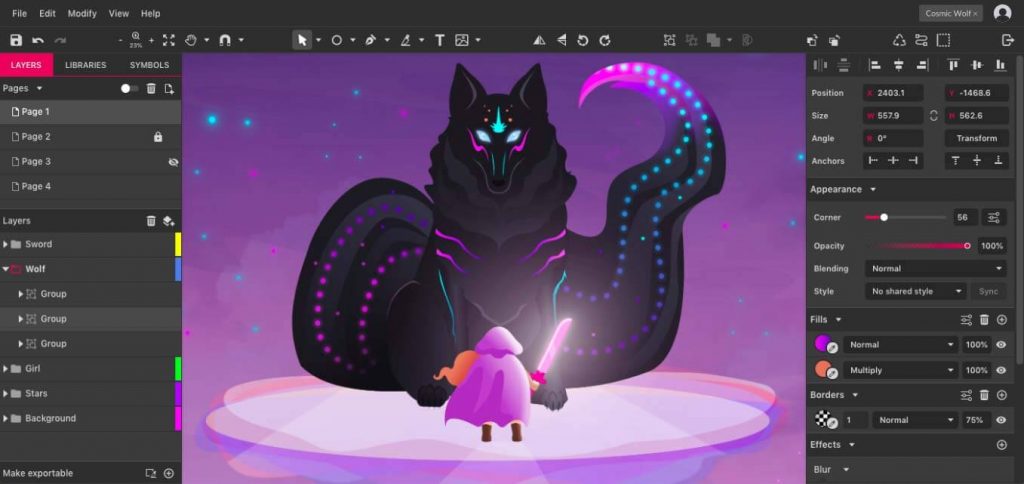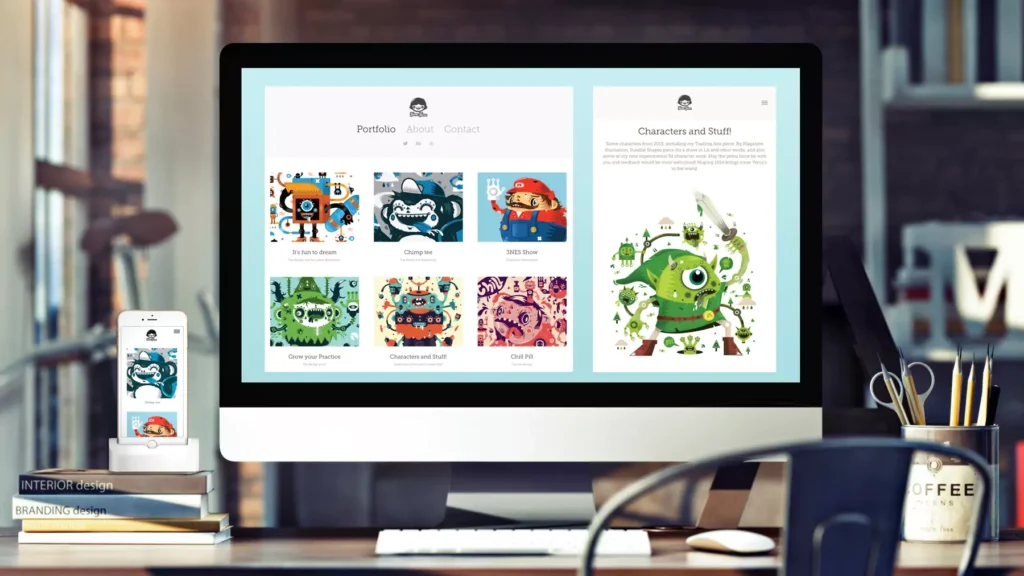How to Become a Graphic Designer: A Comprehensive Guide
Are you a detail-oriented creative person who enjoys telling stories through visuals? If designing unique layouts on blank canvases appeals to you, your true calling is graphic design. However, how do you get started? Don’t worry! In this post, I will show you the thrilling universe of graphics creation. Moreover, I will equip you with all the necessary skills and insider information to enable you to successfully embark on this artistic journey.
So, let’s not waste any time – pick up your pen (or stylus) and jump right into it!
- Graphic design is visual communication that merges creativity with strategic thinking to engage and educate viewers.
- Becoming a graphic designer involves continuous learning and personal growth, transcending natural talent alone.
- A strong portfolio, showcasing diverse work and problem-solving abilities, is essential for landing design jobs.
- Mastering software like Adobe Creative Cloud, Sketch, and Figma is crucial for executing design projects effectively.
- Maintaining a work-life balance and embracing self-care are vital for sustained creativity and avoiding burnout.
Really, What Is Graphic Design?

At its basic level, graphic design is visual communication, an intricate interplay between pictures, typography, and arrangement to narrate tales or express emotions. From logos used by your favourite brands to covers of books that lure you off shelves, everywhere we look, there’s always some form of these designs that influence us about what surrounds us.
But here’s the catch: it is not just about making things beautiful, although that happens too. Graphic design involves strategic thinking mixed with creativity, where one has to represent complicated thoughts in captivating visual forms that will engage and educate viewers at the same time.
The Many Faces of Graphic Design
However, let me show you how dynamic this area is by explaining its various fields before you imagine a life spent sitting in front of a computer fixing pixels one after the other. Graphic design has many specialisation areas characterised by unique challenges and rewards.
- Print Design: This is about creating something tangible and physical, such as magazines or brochures, packaging designs, book covers, etc., designed for print media only.
- Digital Design: Welcome to the World Wide Web, my friend. Web designers rule UI/UX designers reign supreme, and motion graphics artists bring digital interfaces into being while simultaneously creating immersive online experiences.
- Branding & Identity Design: These guys shape brands visually through logos, colour palettes, and visual identities, among other elements that leave an imprint on people’s minds forever (well, almost). They are visual storytellers who know how to touch hearts using their works.
- Illustration & Typography: Here, we talk about art in graphic design. Illustrators and Typographers mostly use their pens, though they can be digital brushes. What matters most is they create eye-catching imagery accompanying texts whose forms themselves seem animated, thus giving life even more depth to any design.
How to Become a Graphic Designer
Natural ability is an asset, but becoming a great graphic designer takes more than talent alone. It is a constant learning process where skills are developed, and personal growth is fostered; it requires dedicating your life towards mastery of the craft.
Before discussing education systems or training programs, let us address the elephant in every artist’s room – the creative block. We’ve all been there before: sitting in front of an empty canvas, waiting for inspiration to strike, but only greeted with deafening silence caused by a lack of imagination.
Fret not! These tips will help you awaken your inner muse and unleash your creativity to make unique designs:
- Saturate Yourself With Inspiration: Surround yourself with great designs, visit art galleries often, flip through design magazines regularly and follow talented creatives on social media platforms. Let their works spark ideas in you and act as springboards into further creative exploration.
- Be experimental: Don’t be afraid to leave your comfort zone by trying new techniques or working with different mediums/stylistic approaches; this keeps things fresh! You need not worry about finding yourself because it is through such artistic adventures that one discovers one's authentic voice/style.
- Collaboration Is Key: Creativity thrives where people work together towards common goals. Find like-minded individuals who share interests similar to yours within the field. Join design communities, whether online or offline forums, etc. and participate in constructive criticism sessions where ideas are exchanged openly, generating new insights and thus pushing boundaries set up around originality.
Formal Education – Laying The Groundwork
Formal education may not be mandatory when pursuing graphic design, but it helps provide a foundational knowledge base upon which everything else can be built. For aspiring designers, this involves enrolling in bachelor's degree programs such as those offered under graphic design/visual communication or any related discipline. These programs introduce students to various aspects, including design principles, colour theory, typography, layout design, and software skills.
Throughout one's studies, one gets to sharpen one's technical abilities and nurture the ability to think conceptually while developing an eye for good designs and being exposed to different disciplines within the industry. Moreover, most schools have internships incorporated within the curriculum. This allows employers to gain hands-on experience when looking for potential employees who can demonstrate practical skills acquired during training through portfolios presented at interviews conducted later on.
Self-Study And Online Resources
Should the traditional educational route seem impractical, there are still numerous online self-study materials where aspiring graphic designers can learn the necessary competencies to succeed in this field.
One advantage of private study is the freedom of customising the learning experience to meet individual needs based on specific interests/goals set out earlier. For instance, focus more deeply on the typographic intricacies of creating logos. Another person may wish to become an expert at branding strategies employed by companies operating in different sectors of the economy and hence need tailor-made resources catering for those areas accordingly.
Building Your Graphic Design Toolkit

In graphic design, your tools are your weapons – the digital equipment that turns creative ideas into reality. There is no single software package to rule them all, but every budding designer requires a few standard programs in the industry.
- Adobe Creative Cloud: Graphic designer's Swiss Army knife; this suite has everything from Photoshop and Illustrator to InDesign and After Effects. Once you’ve mastered these applications, you can easily take on any design project.
- Sketch: Handy for UI/UX designers or anyone working on digital products; Sketch boasts a seamless workflow and powerful vector-based features.
- Figma: This cloud-based design and prototyping tool is relatively new but rapidly growing in popularity thanks to its collaboration-friendly features and cross-platform compatibility.
Knowing how these software programs work is essential, but don’t forget they’re just tools; your creativity and problem-solving skills will make designs stand out.
Sharpening Your Design Eye
While technical abilities are necessary for good graphic design, great designers also have an intuitive understanding of design principles – those fundamental laws or theories which guide successful visual communication. Whether it’s proximity/similarity (gestalt principles), golden ratio, colour theory, etc., grasping these ideas will also enable one to create beautiful and strategic designs.
One approach towards developing a strong sensitivity towards good design can be through studying works by renowned artists and then trying to figure out what makes them so captivating in their own right. Look closely at layout choices next time you come across some fantastic piece of art — pay attention to typefaces used, colours selected, etc.; think deeply about why certain decisions were made here instead of there…you get the picture!
Being Multidisciplinary
Adaptability is crucial in today’s ever-changing world, where specialisation may limit opportunities and the ability to deal with different kinds of jobs depending on current trends or technological advancements. This means that expertise in one area could give someone an added advantage. Successful designers possess a broad range of skills which enable them to take up varied projects while remaining relevant in response to shifts happening around them vis-à-vis new tools available.
For example, besides becoming proficient in designing software applications like Photoshop etc., another skill worth considering developing includes photography:
This is because capturing great images can come in handy in various sectors, such as advertising, editorial design, and branding, where powerful visuals are required to tell stories about products/services. Alternatively, hand-drawn illustrations add a personal touch to digital counterparts, enhancing overall aesthetics and increasing chances of winning potential clients' hearts if used appropriately during creation.
In addition, video editing should be addressed, given its role in social media platforms and motion graphics. This expands creative boundaries and does not forget basic knowledge of copywriting so that everything makes sense, even though the primary focus remains visual communication. Sometimes, words alone may fail to communicate the intended message effectively enough without some form of accompanying visuals.
Continuously adding to what you know broadens your horizons, finding common ground across different fields, thereby improving overall abilities in graphic design.
Building Your Portfolio: Showcasing Your Talents

Establishing a firm portfolio is a process that should start as soon as possible – either in your academic life or during self-study. Every project, assignment or personal exploration can be regarded as an opportunity to create pieces worthy of being included in your portfolio and demonstrate different aspects of your abilities.
While picking works for your collection, try to represent various design disciplines, methods, and styles in which you are proficient. Nevertheless, avoid including everything you have ever done – be picky and select only those items that you consider the most powerful and impactful; quality always prevails over quantity.
Moreover, it may be helpful to consider splitting the portfolio into separate sections or case studies with clear narratives where viewers can see how each piece was created from scratch until its final realisation (concept → execution). Such an approach shows off one's design thinking and lets potential clients/employers perceive problem-solving skills in action.
Showing Your Work: Online vs Offline
Living in the digital era requires having an online presence – this mainly refers to designers. Behance Dribbble and personal websites serve as platforms for sharing projects worldwide. However, it would be wrong not to mention the value of well-made physical portfolios – there is something magical about flipping through actual pages and seeing designs in their intended form.
Nevertheless, whether it’s online or offline presentation of works, remember who will see them and adjust accordingly. For potential clients, show what is relevant for their business field or particular design problem; when going on job interviews, emphasise versatility shown through different pieces that could address specific role requirements.
But don't forget about the ability to explain the thinking behind decisions made while working on any given project as well as challenges faced (and overcome) during its realisation phase — such a level of reflection demonstrates professionalism; besides, this way, you can position yourself more like strategic than just tactical thinker – which is highly appreciated within the graphic design community.
Navigating the Professional Landscape

The world of graphic design is open to many types of work, from being employed by an agency or company as an in-house designer, working for yourself as a freelancer, or even starting your design studio. Each option has its challenges and rewards, so you must consider what you want from life before making any decisions.
Should you choose to freelance over full-time employment, be prepared for this kind of lifestyle where one must wear multiple hats at once; not only will you need creativity but also client acquisition skills and project management abilities, including invoicing knowledge, among others. However, building up clients takes time and effort yet again; however, having a solid network around oneself coupled with using online platforms like Upwork / Fiverr can help bring in constant work.
If You Don’t Evolve, You’ll Go Extinct
Design constantly evolves, new trends pop up daily, and technology makes everything outdated within months. To stay relevant, one must continuously learn new things and understand what the audience wants.
Take the initiative to learn more about the industry by attending conferences or workshops where professionals share knowledge on improving themselves. Also, try interacting with other designers, especially those who are well known – follow them on social media platforms such as Instagram & LinkedIn, among others; this will help broaden one's creative mindset since everyone has different opinions when it comes to creativity itself hence why sharing ideas should never stop growing between people.
Balance It Out: Fuelling Creativity And Wellbeing
Creativity is the primary tool for graphic designers, but like everything else in life, it needs to be taken care of. The design industry can be very demanding, leading one into situations that may cause burnout; therefore, striking a work-life balance should be a priority.
Appreciate the need for breaks now and then, doing things unrelated to work which bring personal satisfaction at heart while also surrounding yourself with friends who are supportive enough both emotionally and physically. Whenever feeling low energy levels, creatively speaking, take time off screens entirely either through exercise or meditation; alternatively, go outside and get some fresh air by taking walks around natural environments like parks, etcetera.
At times, we tend to do our best work when least expected, so remember that self-care isn’t selfishness but rather an unavoidable part if you want sustainable creative excellence to thrive within yourself over a prolonged period.
Conclusion: Embracing the Journey
Being a graphic designer is not merely a career decision but an everlasting commitment towards inventiveness, troubleshooting and artistic development. The route can be meandering, filled with difficulties and times of self-doubt; however, the payoffs are beyond measure.
While beginning this venture, ensure that you welcome the process, remain inquisitive and keep learning. Graphic design is an ever-changing art, with every undertaking, each customer, and all collaborations being opportunities to test their limits and enhance their skills.
Therefore, take a moment, inhale deeply, and then pick up your digital pen (or even actual pen) because creativity knows no boundaries when designing. The universe waits upon your unique perception, innovative approaches, and ability to turn ordinary things into extraordinary ones. Keep going along this path; never stop designing.
FAQs:
Do I need a diploma so that they could be a graphic designer?
Formal education in graphics arts can be helpful as an establishment, but it’s not mandatory. Countless successful designers have taught themselves the basics or followed unconventional paths like taking online courses or completing internships. The most crucial thing is building up an impressive portfolio filled with diverse work that exhibits technical skill and creativity.
Which software should I learn?
Adobe Creative Cloud is considered the industry standard because it includes popular programs such as Photoshop, Illustrator, InDesign and After Effects; however, one might also want to look into other tools like Sketch (for UI/UX design) or Figma (for collaboration and prototyping). Ultimately, you should concentrate on mastering whichever software aligns best with your interest or expertise.
How important is having a portfolio when applying for graphic design jobs?
As a graphic designer, your portfolio is everything. It’s a curated selection of your best work that demonstrates your abilities to think conceptually, problem-solve visually and produce aesthetically pleasing designs across various mediums such as print materials or digital interfaces – anything someone might hire one to create! In short, spend time creating good content that people will want to see!
Can I focus on just one area of graphic design?
Yes: there are many fields within this profession, including but not limited by illustration, branding & identity systems development (logos, etc.), web page layout creation/design, etc.; however, do keep in mind that versatility never hurts anybody either, so try not pigeonholing oneself too early on.
How do freelancers find clients?
Building up clientele takes hard work for every freelancer, whether you are just starting or have been doing it for years already. Some suggestions would include utilising sites like Upwork/Fiverr/etc., attending local meet-ups where potential employers may be present (or even other professionals whom partnerships could form), and giving 110% effort on each project, which can result in positive reviews and word-of-mouth recommendations—actively promoting self via social media plus own website alongside more traditional methods like attending conventions or handing out business cards.
How can I stay inspired + avoid burning myself out?
One of the biggest challenges graphic designers face is staying motivated when faced with tight deadlines and demanding clients; burnout doesn’t have to be inevitable. Some strategies that may help include taking care of oneself (i.e., eating right, getting enough sleep), finding an outlet for creative energy outside work hours, i.e. through personal projects/hobbies, etc., and surrounding oneself with supportive people. These people understand what one does for a living and appreciate its value on a more profound level—going out into nature occasionally — anything that keeps one’s mental batteries up!
Which abilities or personality traits are necessary for success within this field?
Most successful graphic designers possess strong communication skills, adaptability/time management chops, attention-to-detail tendencies, and the ability to handle criticism without becoming defensive. All these will be highly sought-after attributes should anyone ever wish to pursue a career in this fast-paced industry!

